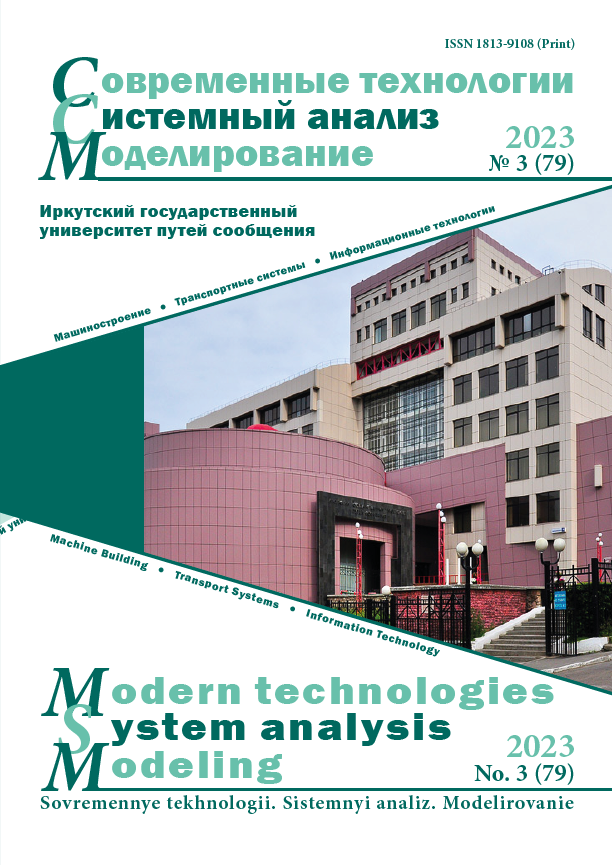Increasing the regulation quality of asynchronous induction motors with modal control
Keywords:
asynchronous motor, vector control, modal control, characteristic polynomial, matrix calculation, mathematical modelingAbstract
To date, the application scope of asynchronous machines is the most extensive. Asynchronous motors are used not only in industry as conveyor drives or supply and exhaust ventilation, but also in railway transport. Low-power asynchronous motors are used in motor-fan and motor-compressor units, as well as for phase splitters’ drives. The development trend of electric vehicles is not limited to the use of low-power engines only. Nowadays, asynchronous machines are also used as traction motors for electric rolling stock. The paper discusses issues of improving the quality of regulation of an asynchronous motor by reducing the time of transient processes into dynamic ones. The main objective of the work is to develop a modal control system for the operation of an asynchronous motor, ensuring the specified quality indicators of the automatic control system. A description and simulation results of transient processes in the flux linkage and engine speed channels when using a modal controller are presented. A comparative analysis of the operation of an asynchronous motor with a vector control system using a modal controller and without it was carried out. The results of the analysis confirmed the prospects of using modal control when operating an asynchronous motor. The corresponding graphs of the transient process were obtained, confirming the attainment of the specified control time when using a modal controller. A conclusion has been formulated about the effectiveness of using the method of modal control of an asynchronous motor.
References
Костенко М.П. Электрические машины. Специальная часть. Л. : Госэнергоиздат, 1949. 708 с.
Колпаков А. Перспективы развития электропривода // Силовая электроника. 2004. № 1. С. 46–48.
Branko Blanusa. New Trends in Efficiency Optimization of Induction Motor Drives // New Trends in Technologies : Devices, Computer, Communication and Industrial Systems. Publ. 2010. Р. 341–358. DOI 10.5772/10427.
Лазарев Г. Высоковольтные преобразователи для частотно-регулируемого электропривода. Построение различных си-стем // Новости электротехники. 2005. № 2 (32). С. 15–20.
Филиповский В.М. Системы управления в пространстве состояний. СПб. : СПбПУ, 2022. 75 с.
Шонин О.Б., Пронько В.С. Энергосберегающие алгоритмы частотного управления асинхронным приводом с уточнени-ем области минимума потерь на основе методов нечеткой логики // Записки Горного института. 2016. Т. 218. С. 270–280.
Моделирование векторного управления асинхронным приводом вспомогательных машин электроподвижного состава / Ю.М. Кулинич, С.А. Шухарев, В.К. Духовников и др. // Вестн. науч.-исслед. ин-та ж.-д. трансп. 2022. Т. 81, № 1. С. 23–30.
Герман-Галкин С.Г., Карташов Б.А., Литвинов С.Н. Модельное проектирование электромеханических мехатронных мо-дулей движения в среде SimInTech. М. : ДМК Пресс, 2021. 494 с.
Blaschke F. Das Prinzip der Feldorientierung, die Grundlage für die Transvektor-Regelung von Drehfeldmaschinen // Siemens-Zeitschrift. 1971. Vol. 45. S. 757–760.
Дорощенко И.В., Погуляев М.Н. Имитационная модель асинхронной машины с фазным ротором в MatLab Simulink // Вестн. Гомел. гос. техн. ун-та им. П.О. Сухого. 2021. № 2 (85). С. 99–106.
Панкратов В.В., Зима Е.А., Нос О.В. Специальные разделы современной теории автоматического управления. Новоси-бирск : НГТУ, 2007. 218 с.
Пахомов А.Н., Федоренко А.А., Чертыков П.Н. Модальное управление асинхронным электроприводом тележки мо-стового крана с наблюдающим устройством // Журн. Сибир. федерал. ун-та. Сер. Техника и технологии. 2022. Т. 15. № 5. С. 583–592.
Vas P. Sensorless Vector and Direct Torque Control. Oxford : Oxford University Press, 1998. 729 p.
Пахомов А.Н., Коротков М.Ф., Федоренко А.А. Модальное управление электроприводом переменного тока // Вестн. Сибир. гос. аэрокосмич. ун-та им. акад. М.Ф. Решетнева. 2011. № 3 (36). С. 70–74.
Васильев Е.М., Сердечная Е.А., Таволжанский А.В. Синтез высокоточных систем модального управления // Вестн. Во-ронеж. гос. техн. ун-та. 2020. Т. 16. № 5. С. 56–63.
Дылевский А.В. Применение многочленов Баттерворта для построения модальных дифференциалов // Вестн. Воронеж. гос. ун-та. Сер. Системный анализ и информационные технологии. 2020. № 1. С. 28–35.
Проектирование регуляторов систем управления / В.В. Григорьев, В.И. Бойков, А.В. Парамонов и др. СПб. : ИТМО, 2021. 94 с.
Синтез систем автоматического управления методом модального управления / В.В. Григорьев, Н.В. Журавлёва, Г.В. Лукьянова и др. СПб. : ИТМО, 2007. 143 с.
Автоматизация электроподвижного состава / А.Н. Савоськин, А.В. Плакс, Л.А. Баранов и др. М. : Транспорт, 1990. 312 с.


